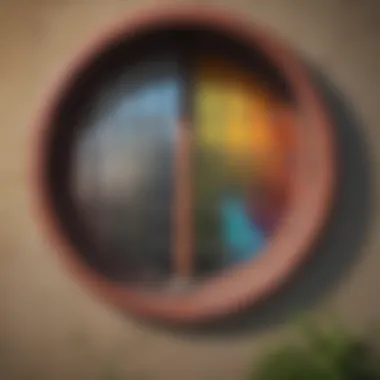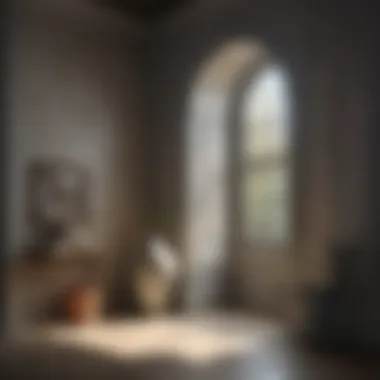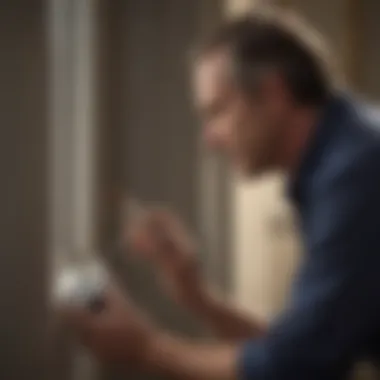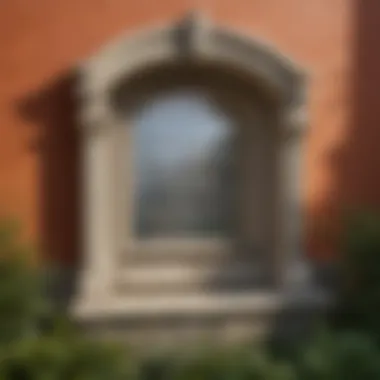The Ultimate Guide to Choosing Window Well Paint


Intro
Understanding window well paint is fundamental for any homeowner concerned with safety and aesthetics. Window wells are typically found in basements, allowing light into the space while providing egress in case of an emergency. Over time, without proper care and paint treatment, these wells can deteriorate, both in function and appearance.
Importance of Window Well Paint
The role of paint goes beyond looks. Applying the right kind of window well paint not only enhances the visual appeal of your home but also protects the structure from dampness and decay, which can lead to costly repairs. Weather-resistant and carefully chosen paints can stand up against elements like rain, snow, and extreme temperatures. Maintenance also becomes easier when the proper paint is used, reducing the need for frequent touch-ups and prolonging the lifespan of the window well.
Overview of Specific Issues
Without appropriate treatment, issues such as rust, rot, and discoloration can arise. Homeowners may also face safety concerns, as dirty or poorly maintained wells can hinder safe exit during an emergency. Overall, selecting quality paint for window wells is essential in safeguarding your home and maintaining its exterior aesthetics.
Prelude to Window Wells
Window wells serve a crucial function in residential architecture, linking the interior of a home to the exterior and ensuring easy passage of light and air into basement living spaces. This introductory section delves into the essentials of window wells, highlighting their significance not only for the aesthetic value but also for maintaining safety and functionality within a building. Window wells become increasingly important in maintaining structural integrity while providing the necessary natural light. Moreover, they play a role in diverting soil and water away from window seals, which is vital for the longevity of these areas.
Purpose of Window Wells
The primary purpose of window wells is to provide an opening to access light and ventilation while preventing water accumulation around basement windows. They act as barriers, protecting the window from dirt and moisture, which could compromise the glass as well as surrounding frames and components. Furthermore, such wells allow homeowners and builders to enhance the aesthetics of a property's exterior. Often used in homes with below-grade windows, window wells help create a more inviting and brighter space indoors. They also contribute to safety by preventing falls into unfinished basement areas.
Basic Components
Understanding the basic components of window wells is essential. Typically, a window well consists of the following parts:
- The Well: The cavity dug out to house the direct window area.
- The Grate: Usually made of metal or plastic, this component covers the well and prevents debris from entering while allowing light to filter through.
- Drainage System: Some wells incorporate a drainage system to prevent moisture buildup, this can include a pipe or pebbles.
- Backfill: The soil surrounding the well; helps prevent concrete from cracking due to pressure from outside.
These elements distinguish a functional and effective window well from one that could bring about problems down the line. Use of quality materials is important to manage their long-term maintenance and efficiency. As this article progresses, various aspects of window well paint and preservation will become clearer, emphasizing their necessity in this architectural feature.
Understanding Window Well Paint
Understanding window well paint is essential for homeowners looking to ensure the longevity and aesthetic appeal of their properties. The use of appropriate paint not only protects the window wells from weather damage but also enhances their overall appearance. By investing time and resources into window well paint, one can achieve a more attractive and functional home environment.
Role of Paint in Preservation
The preservation role of window well paint cannot be overstated. Over time, window wells can be subject to harsh elements such as rain, snow, and sunlight. Window well paint serves as a protective barrier against corrosion, rust, and decay. This prevents structural issues that could arise from water damage.
When selecting the paint, consider durability as a primary factors. Oil-based paints are often favored for their robustness but demand longer drying times. Alternatively, water-based paints offer easier cleanup and quicker drying. By coating these areas, the paint helps to repel moisture, an essential property considering how close window wells are to earth. Dirt and water can infiltrate if not properly treated, leading to potential leaks in your home's foundation.
Additionally, paint provides UV protection. This helps maintain the integrity of the window wells, not allowing them gray and dull over time. A well-preserved well can avoid costly repairs in the long run.
Aesthetic Enhancements
Aesthetic enhancements are also a significant consideration when it comes to window well paint. A freshly painted window well can rejuvenate the appearance of a home. By choosing the correct color and finish, homeowners can align their window wells with the overall style of their property.
Consider these factors for aesthetic enhancement:
- Color Choices: Darker colors can make wells appear smaller, while brighter colors tend to open up spaces. The choice often depends on personal preference and the surrounding architecture.
- Finishes: Matte or satin finishes can give a different look and feel than gloss finishes. The used finish impacts light reflections and shadows in the surrounding area.
- Artistic Options: For those looking to add character, decorative techniques such as stenciling can be used to incorporate designs on the wells, merging beauty and utility.
Types of Window Well Paint
Choosing the appropriate type of window well paint is crucial for both functionality and aesthetic appeal. Each type offers unique benefits and challenges, contributing to the overall effectiveness of the paint. Considering factors such as durability, adhesion, and weather resistance is key when selecting the right paint for your window wells. Homeowners must be well-informed about each option available in the market to ensure longevity and satisfactory appearances.
Oil-Based Paints
Oil-based paints are a classic choice for painting window wells due to their robustness. They provide a durable finish that can withstand the elements well, making them suitable for outdoor environments. This kind of paint tends to adhere exceptionally well to metal and older surfaces, creating a barrier resistant to moisture and rust.
One of the noticeable characteristics of oil-based paints is their slow drying time. While this allows for smooth application, it may require some patience. Homeowners should also anticipate potential fumes from the paint, necessitating proper ventilation during and after application.
In terms of maintenance, these paints are easy to clean. A simple scrubbing with soap and water usually suffices to keep them looking good.
Pros:
- Strong adhesion and durability
- Resistance to moisture and rust
- Simple cleaning process after application
Cons:
- Longer drying times needing proper ventilation
- Often higher in VOCs (volatile organic compounds)
Water-Based Paints
Water-based paints have been gaining popularity for their environmentally friendly components and ease of use. They dry faster than oil-based paints, enabling quicker application and less waiting time between coats. Applicators find that water-based paints are easier to clean up, needing only soap and water. This convenience is a significant advantage for those who prioritize ease during the painting process.
Nevertheless, water-based paints might not offer the same level of adhesion on some non-porous surfaces compared to oil-based options. Hence, thorough surface preparation is critical. Overall, these paints are less toxic, making them a good choice for safety-minded individuals who often handle such adhesive materials.
Pros:
- Faster drying time
- Easier to clean up
- Lower toxicity and environmental impact
Cons:
- May require thorough surface prep
- Less durability on non-porous surfaces


Epoxy-Based Paints
Epoxy-based paints present another option specifically beneficial for high-durability requirements. These paints often consist of two components: a resin and a hardener. They create a strong, chemical-resistant coating suitable for both indoor and outdoor uses. Many homeowners consider it for window wells due to its toughness against impact and abrasion.
When applying epoxy paints, individuals must make sure to mix the ingredients thoroughly and work swiftly since these paints usually have a limited application window. Homeowners might find them challenging to use but rewarding in terms of performance. Once cured, epoxy-based options result in a solid finish that resists stains and enhances durability significantly.
Pros:
- High chemical resistance
- Excellent durability against wear and tear
- Ideal for surfaces requiring a tough coating
Cons:
- More complex application process
- Requires precise mixing of components
When assessing types of window well paint, consider your long-term goals regarding aesthetic appeal, durability, and ease of application.
Preparing for Window Well Painting
Preparing the window well before painting is a critical step. It involves a series of actions that ensure the paint adheres properly and lasts longer. This stage not only builds a strong foundation for a successful painting project but also reduces the chances of common issues like peeling and fading.
Cleaning the Surface
Cleanliness is essential in the painting process. Before starting, you need to ensure the window well is free from dirt, debris, and old paint.
- Remove Debris: Start by taking out any leaves, rocks, or fallen branches. This clears the area.
- Wash Well: Using water and a stiff brush, clean the well's interior. For heavly curated residues, a mild soap can assist in this.
- Rinse and Dry: Once clean, rinse with clean water. It is important to allow the surface to dry completely. This simplby ensures the new paint adheres to a clean and dry surface.
A thorough cleaning process not just enhances adherences but also improves the wonderful appearance of the painted surface.
Repairing Damages
Inspecting the well for damages should follow cleaning. Addressing any repairs required is vital before any paint application. This ensures protection and aesthetics in result.
Two common problems to address typically include:
- Cracks: Small fissures can reduce the appearences and eventually destabilize the structure. Using a concrete patch can resolve these effectively.
- Rust: If there is any metal parts affected, make sure to treat it with a rust inhibitor. This step prevents the paint from failing prematurely.
Once repairs are done and cured, the surface will be ready for new paint. Leaving or neglecting current damages can lead to further surface corruption and costly future repairs.
Choosing the Right Paint
Choosing the right type of paint is crucial for results. Many types of paint are availables, but the right one depends on the material and environmental conditions of your window well.
When deciding, consider:
- Type of Material: Different materials require different paints. The paint formulation often dictates its appropriateness for various surfaces.
- Environmental Factors: If the window well is exposed to moisture, a water-resistant or balcony paint might be a preferred choice.
- Final Appearance: Consider the aesthetic too. Several colors and finishes are available in both oil-based and water-based options to coordinate well with your house design.
In summary, a proper cleaning, effective repairs, and suitable paint selection will greatly influence the longevity and visual appeal of your window well painting project.
Application Techniques for Window Well Paint
The application techniques for window well paint play a significant role in ensuring the durability and aesthetics of the surface. Proper application not only contributes to a polished appearance but also extends the lifespan of the painted surface. These techniques consider the type of material used, the environmental conditions at the time of painting, and the tools needed. A well executed painting project protects the window wells from moisture and wear, enhancing structural integrity and visual appeal.
Essential Tools and Materials
To achieve optimal results in window well painting, certain tools and materials are essential. Gather the following items:
- Paint rollers or brushes: Choose these based on the paint type and accessibility of the window wells.
- Paint tray: This is useful for easy paint access.
- Drop cloths: Protect surrounding areas from paint spills or splatters.
- Paint primer: This increases adhesion and enhances finish quality.
- Sealer: A water-resistant sealer can further protect the finish.
- Lint-free rags: These are necessary for cleaning surfaces.
- Protective gear: Gloves, mask, and safety glasses protect from any splatters or harmful fumes.
Establishing the right toolkit prevents mistakes and ensures smooth work.
Step-by-Step Application Process
Following an organized application process promotes consistent results:
- Preparation: Begin with cleaning the window well surface to remove dirt and debris. Use a stiff brush and soapy water for stubborn stains.
- Surface Inspection: Check for damages and repair any issues. Cracks should be filled with appropriate filler material to create an even surface.
- Priming: Apply a primer coat to enhance paint adhesion. This is particularly important for metal or untreated surfaces. Allow it to dry completely.
- Painting: Using a paint roller or brush, apply a first coat of window well paint. Work carefully in sections, maintaining even coverage.
- Additional Coats: It is advisable to apply at least a second coat once the first is dry. Ensure that every coat flows seamlessly to avoid texture differences.
- Final Touch-ups: After the last coat dries, inspect for missed spots and add necessary touch-ups.
Drying and Curing Times
Understanding drying and curing times is fundamental to achieving a satisfactory finish. Factors influencing these times include humidity, temperature, and ventilation. Typically, window well paints may have:
- Touch Dry Time: Usually 1 to 2 hours post-application.
- Recoat Time: Most paints suggest a recoat in 4 to 6 hours.
- Full Cure Time: Allow 7 to 14 days for the paint to reach its maximum toughness.
Taking time with the proper procedures results in a polished and long-lasting finish for window wells.
Post-Application Care
Post-application care is crucial for ensuring the longevity and effectiveness of your window well paint. After investing time and effort into painting, you want the results to last. Proper post-application practices can enhance durability, maintain aesthetics, and protect your investment. This section discusses the steps necessary for post-application care, focusing on key elements like flaw inspection and cleaning guidelines.
Inspecting for flaws
Once the paint is dry, it's imperative to carry out a thorough inspection. Look for cosmetic defects such as streaks, uneven coats, or defects like peeling. If issues are discovered early on, such as small bubbles or an irregular texture, these can often be treated without a complete repaint. Use a flashlight to illuminate areas, allowing for close diagnostics of potential problems.


- Surface Quality: Walk around the window well to assess the surface from different angles.
- Touch Test: Lightly run your hand over surfaces to feel for unevenness or rough areas.
- Viewing for Reflection: Check how the light reflects off the paint surface. Discrepancies can highlight imperfections.
If any of these points raise concern, corrective steps should be taken immediately to ensure the best results. Quick action can save time and additional costs in the future, reinforcing the value of a disciplined approach to maintaining your window well aesthetics.
Remember: Minor imperfections may not significantly compromise performance but can illustraste future deterioration if left unattended.
Cleaning Guidelines
Keeping your painted window wells looking vibrant and ready for effort requires a solid cleaning regimen. Proper cleaning minimizes harm and retains the attractive finish. While it might seem daunting, establishing simple cleaning routines can protect against wear.
- Avoid Harsh Chemicals: Use mild detergents designed for painted surfaces. Avoid heavy abrasives or surfing that can scratch the paint off.
- Gentle Tools: Opt for soft bristle brushes or sponges when cleaning. Avoid hard brushes that could mar the coating.
- Regular Cleaning Schedule: At least twice a year is recommended, particularly in spring and fall. Regular cleaning can prevent accumulation of dirt and debris.
By systematically checking for flaws and establishing realistic cleaning habits, windows can maintain their appeal. It's about wellness rather than neglect, ensuring a well-maintained look that lasts through seasons. In summary, effective post-application care contributes to the paint’s longevity and overall structure safety.
Common Issues with Window Well Paint
In the realm of window well maintenance, addressing the common issues related to window well paint is paramount. Windows wells serve as essential structures that enhance safety and accessibility in homes. Understanding potential problems that can arise from paint applications ensures longer-lasting finishes and greater overall satisfaction. Two pervasive issues that homeowners often encounter are peeling and cracking, as well as discoloration.
Peeling and Cracking
Peeling and cracking of window well paint can drastically undermine both the aesthetic and protective qualities of the surface. When paint begins to lift away from the structure, it exposes the underlying material to moisture and other elements, leading to deterioration over time.
Several factors can contribute to peeling and cracking:
- Poor surface preparation before application.
- Using a paint product that is not suitable for the conditions of the window well environment, such as humidity or temperature fluctuations.
- Inadequate curing time, which can trap moisture beneath the paint layer.
This emphasizes the importance of proper preparation and selection.
Prevention methods include:
- Ensuring thorough cleaning of the surface before application.
- Choosing high-quality paint that fits the environmental conditions.
- Following manufacturer guidelines for drying and curing times.
Discoloration
Discoloration is another standard issue that can affect the appearance of painted window wells. Over time, exposure to sunlight, rain, and other environmental factors can cause paint to fade or change color. This not only detracts from the overall look of the window wells but also signals that paint may be losing its protective attributes.
Sources of discoloration may include:
- UV rays from the sun that cause fading.
- Algal or mold growth that can develop due to cling moisture issues.
To combat discoloration effectively:
- Regular maintenance should be practiced, including cleaning to prevent mold growth.
- Be cautious when selecting materials that are known for their durability against UV exposure, such as fade-resistant paints. Higher-quality options may have an added cost, but they provide longer expiration times and fewer maintenance burdens.
Investing in quality products can improve longevity and minimize repair interventions down the line.
Identifying and addressing these common issues reinforces better decisions regarding maintenance and enhances the safety and aesthetic appeal of home environments. Proper attention to detail in both high-quality preparation and product selection can lead to lasting beautiful results.
Environmental Considerations
Understanding environmental considerations when painting your window wells is crucial. This section evaluates sustainable practice, potential waste disposal impacts, and how conscientious decisions can positively influence both your surroundings and personal habits.
Sustainability of Materials
Using sustainable materials benefits not just personal projects but the broader environment. Many paint manufacturers now offer eco-friendly paints. These products often use water-based formulas, which contain fewer volatile organic compounds (VOCs) compared to their oil-based counterparts.
Opting for low-VOC paints reduces environmental pollution and improves indoor air quality. Furthermore, many of these sustainable options are made from recycled materials or are naturally sourced. A homeowner should look for products that have certifications indicating they meet specific environmental standards, such as the Green Seal or EcoLabel certifications.
Additionally, these sustainable paints tend to have comparable durability. The misconception that eco-friendly means inferior quality is outdated. While shopping, select materials that harmonize aesthetic appeal and eco-conscious attributes.
Waste Disposal Guide
When painting your window wells, waste disposal is a critical aspect to consider. Proper disposal of leftover paints and materials is necessary for avoiding environmental harm. First, review local regulations about paint waste—you can often find this information on municipal websites.
Never pour leftover paint down the drain or throw it in the regular trash. Instead, consider the methods below:
- Dry up old paint: Open the container and let air exposure properly dry it out. Once solid, it can typically be disposed of with the general waste.
- Reuse whenever possible: Leftover paint can sometimes be mixed for touch-ups or future projects. If this is not an option, give it away to community centers or schools.
- Visit local hazardous waste collection events: Many towns have scheduled days to safely dispose of hazardous materials, including paints.
Choosing an environmentally-friendly approach results in safer practices at home and contributes towards greater sustainability on a larger scale.
“By being nature-conscious in choices regarding materials and disposal, homeowners are making a responsible investment for future generations.”
Incorporate sustainable habits into your window well projects. This becomes a shared responsibility toward a cleaner, greener living space.
Window Well Paint and Safety
The importance of window well paint in relation to safety cannot be understated. Properly applied paint not only enhances the appearance of window wells but also plays a crucial role in preventing accidents and ensuring longevity. The enhanced visibility brought on by an effectively painted window well can alert individuals to its presence, reducing the chances of slips or falls. Moreover, for homeowners aiming for striking aesthetics, addressing safety concurrently is imperative.
Slip Hazard Mitigation
Assessing the sliding risk around window wells is vital. Natural wear from weather and time may lead to slippery surfaces. This situation may be worse after rain or snowfall, creating a serious safety risk, especially for children or elderly individuals. Window well paint can help mitigate this hazard in various ways.


- Textured Finishes: Applying a textured paint offers better grip compared to smooth surfaces.
- Non-Slip Additives: Many window well paint options include additives purposely created to increase grip. Using these will enhance safety significantly.
- Reflective Surfaces: Adding paint that reflects light will not only improve the visibility at night but also assists in easily identifying danger zones by increasing their contrast under artificial lighting.
To ensure utmost safety, consider adding anti-slip tape for an additional layer of protection, particularly in areas subject to high moisture.
Cost Analysis of Window Well Painting
Cost analysis is critical in the process of painting window wells. Understanding the overall expenses involved helps homeowners make informed decisions. An effectively planned budget not only prevents overspending but also ensures that safety and aesthetics are optimized without compromising on quality. It is essential to account for both material and labor costs while factoring in any potential extra expenses. This makes a well-rounded assessment a necessary part of the project.
Estimating Material Costs
Material costs can vary significantly based on the types of paint used and the size of the window well. Several factors influence these costs:
- Type of Paint: Prices fluctuate between oil-based, water-based, and epoxy-based paints.
- Quantity Needed: Larger window wells require more paint, thus increasing totals.
- Additional Supplies: This includes tools such as brushes, rollers, drop cloths, and cleaning solutions.
For a rough estimate, homeowners should measure the surface areas and calculate the volume of paint needed. Always consult product labels for coverage guidance. It is also wise to account for a 10% excess to cover imperfections or the unexpected, ensuring that everyone can stay within their budget.
Labor Costs Considerations
Labor costs form a substantial part of the window well painting budget. Several elements can impact the overall expenditure:
- Professional Services vs. DIY: Hiring experts often guarantees a high standard of finish but can double or triple labor costs compared to a do-it-yourself approach.
- Location Influences: Costs may vary depending on geographic location. Higher living costs in cities can drive up labor rates.
- Time Taken: Complex projects may take longer, yielding increased labor loader.
Ultimately, comprehending both material and labor costs enables more strategic financial planning and encourages a successful, aesthetically pleasing window well treatment. Understanding and assessing these considerations can offer significant benefits, aligning budget with desired outcomes.
Comparative Analysis of Brands
A comparative analysis of brands is crucial in understanding the range of options available for window well paint. Given the investment involved in painting, homeowners want results that blend durability with aesthetic appeal. Here, several factors stand out when delving into well-known and emerging brands. The scope includes performance metrics, varying price points, and unique characteristics of widely recognized products. By evaluating these elements, one can make informed decisions tailored to personal needs and preferences.
Established Brand Reviews
Reviews of established brands form an important base in this comparative analysis. For instance, Sherwin-Williams is a household name when it comes to quality and range of paint types. They offer various products suitable for window wells, providing durability against moisture and temperature fluctuations.
Another significant option is Behr. It is well-regarded for offering cost-effective solutions without compromising on quality. Their products often feature self-priming qualities, which can save time and increase effectiveness in surface adhesion.
Lastly, Benjamin Moore is also notable for premium exterior paints. They focus on vibrant pigments and provide extensive warranties covering their spreads. These established brands set standards and provide concrete examples to draw inspiration from.
Emerging Brands Discussion
On the other end of the spectrum, new and emerging brands are becoming part of the conversation in the window well paint space. Companies like Rust-Oleum are gaining appreciation for innovative and affordable solutions. Rust-Oleum recently emphasized sustainability, with a growing offering of eco-friendly paints, merging quality with environmental consciousness.
Farrow & Ball is another emergent player regarded for its artisanal aesthetic and unique color palettes. While often more expensive, their products attract homeowners interested in standing out visually, bringing characteristic uniqueness in style.
Innovative Trends in Window Well Treatment
Innovative trends have emerged in window well treatment, presenting practical solutions for homeowners while elevating aesthetics. This section provides necessary insights into technical advancements and future developments, considering how these influence durability and design.
Technology Integration
Integration of technology into window well treatment is reshaping the way homeowners approach maintenance. Smart technology, for example, now allows owners to monitor their window wells effectively. Using sensors, they can receive real-time feedback about conditions, such as water accumulation or structural issues. This proactive management can significantly extend the life of the paint and window wells themselves.
In today's market, some companies incorporate moisture sensors and carbon monoxide detectors integrated within window well systems. This addition enhances safety by alerting homeowners to potential threats before they escalate. Moreover, innovative coatings are being developed, utilizing nano-technology. These paints create a protective barrier that is resistant to peeling, cracking, and fading, prolonging the repainting interval.
Benefits of Technology Integration
- Enhanced Monitoring: Homeowners can have an immediate understanding of their window well conditions.
- Increased Safety: Smart sensors decrease the risks of flooding and other hazards.
- Longevity of Materials: Advanced coatings protect against wear and can save money in the long run.
Future Developments
The future of window well treatment points towards an increased sustainability focus. Manufacturers are concocting not just coatings but entire systems designed to minimize environmental impact.
For example, plants and materials that benefit from a circular economy are provfoundly under exploration. Paints formulated from recycled materials can make window wells not only visually pleasing but also eco-friendly. This not only reduces reliance on contentious resources but addresses quality too—some eco-friendly products demonstrate excellent adherence and durability compared to traditional options.
Another projected avenue involves self-cleaning surfaces, reducing maintenance burdens on homeowners. Imagine a window well that actively prevents dirt build-up, extending the visual improvement paint provides. Advances in UV protection techniques could also be leveraged to create paints resistant to fading against sunlight exposure.
Considerations for the Future
Homeowners should remain abreast of the trends that make treatment processes smarter, safer, and more sustainable. Categories of innovation can include:
- Environmental mindfulness in product development
- Integration of self-cleaning technologies
- Use of intelligent materials focusing on adaptability for diverse home structures
In summary, as the field evolves, the application of technology in window well treatment becomes more critical for those interested in combining functionality with aesthetics. By staying updated on these trends, homeowners can make informed decisions, maintaining the integrity and charm of their residential spaces while embracing a responsible approach.
The End
The conclusion draws together significant insights from the extensive information provided in this guide on window well paint. Understanding the intricacies of window well treatment is crucial for homeowners and professionals alike. This guide has outlined the various aspects of window well paint, from preparation and application techniques to long-term maintenance. By grasping these concepts, one can not only enhance safety but also elevate the visual aesthetics of residential properties.
Summary of Key Points
- Importance of Window Well Paint: Window well paint serves a dual purpose of preservation and aesthetics. It can shield the wells from moisture and environmental elements, extending their lifespan.
- Types of Paint: Different types of paint, such as oil-based, water-based, and epoxy-based, offer unique properties. These differ in durability, drying times, and ease of maintenance.
- Surface Preparation: Proper preparation involves cleaning and repairing the surface. Ignoring this step can lead to paint failure and inadequate protection.
- Application Techniques: Learning proper techniques ensures a smooth and long-lasting finish. Factors like drying and curing times are critical to achieving the desired durability.
- Post-Application Care: Regular inspections and maintenance practices help identify issues early, such as peeling or discoloration.
- Environmental Considerations: Choosing sustainable materials and responsible disposal methods are becoming increasingly relevant in today’s DIY culture.
Final Recommendations
For effective window well treatment, here are several recommendations:
- Evaluate Your Current State: Assess the existing condition of your window wells before you start. Check for any damages that require urgent repairs.
- Choose the Right Paint: Be particular about selecting a paint type that best suits environmental conditions and existing materials. Investing in a high-quality product pays off in the long run.
- Follow Manufacturer Instructions: Always adhere to the guidelines provided by the paint manufacturer for application and safety precautions.
- Engage in Long-Term Maintenance: Make inspections a regular part of home upkeep. Check for paint deterioration every few months to avoid serious issues.
- Consider Professional Help: Should the task seem daunting, or if specialized techniques are required, consider hiring professionals for the job.
Ultimately, recognizing the benefits of window well paint and applying this knowledge can greatly enhance both safety and the overall look of your home.







